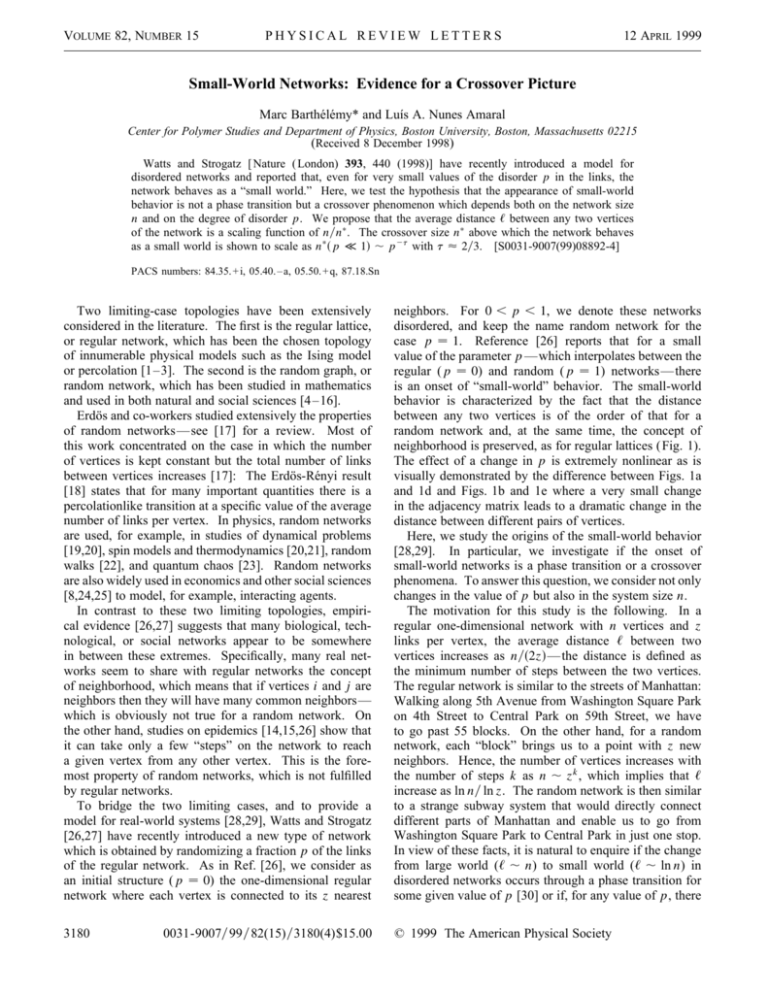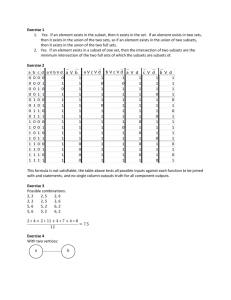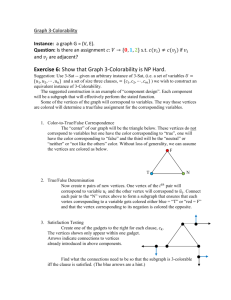Small-World Networks: Evidence for a Crossover Picture
advertisement

VOLUME 82, NUMBER 15 PHYSICAL REVIEW LETTERS 12 APRIL 1999 Small-World Networks: Evidence for a Crossover Picture Marc Barthélémy* and Luı́s A. Nunes Amaral Center for Polymer Studies and Department of Physics, Boston University, Boston, Massachusetts 02215 (Received 8 December 1998) Watts and Strogatz [ Nature ( London) 393, 440 (1998)] have recently introduced a model for disordered networks and reported that, even for very small values of the disorder p in the links, the network behaves as a “small world.” Here, we test the hypothesis that the appearance of small-world behavior is not a phase transition but a crossover phenomenon which depends both on the network size n and on the degree of disorder p. We propose that the average distance , between any two vertices of the network is a scaling function of nynp . The crossover size np above which the network behaves as a small world is shown to scale as np s p ø 1d , p 2t with t ø 2y3. [S0031-9007(99)08892-4] PACS numbers: 84.35. + i, 05.40. – a, 05.50. + q, 87.18.Sn Two limiting-case topologies have been extensively considered in the literature. The first is the regular lattice, or regular network, which has been the chosen topology of innumerable physical models such as the Ising model or percolation [1–3]. The second is the random graph, or random network, which has been studied in mathematics and used in both natural and social sciences [4–16]. Erdös and co-workers studied extensively the properties of random networks—see [17] for a review. Most of this work concentrated on the case in which the number of vertices is kept constant but the total number of links between vertices increases [17]: The Erdös-Rényi result [18] states that for many important quantities there is a percolationlike transition at a specific value of the average number of links per vertex. In physics, random networks are used, for example, in studies of dynamical problems [19,20], spin models and thermodynamics [20,21], random walks [22], and quantum chaos [23]. Random networks are also widely used in economics and other social sciences [8,24,25] to model, for example, interacting agents. In contrast to these two limiting topologies, empirical evidence [26,27] suggests that many biological, technological, or social networks appear to be somewhere in between these extremes. Specifically, many real networks seem to share with regular networks the concept of neighborhood, which means that if vertices i and j are neighbors then they will have many common neighbors— which is obviously not true for a random network. On the other hand, studies on epidemics [14,15,26] show that it can take only a few “steps” on the network to reach a given vertex from any other vertex. This is the foremost property of random networks, which is not fulfilled by regular networks. To bridge the two limiting cases, and to provide a model for real-world systems [28,29], Watts and Strogatz [26,27] have recently introduced a new type of network which is obtained by randomizing a fraction p of the links of the regular network. As in Ref. [26], we consider as an initial structure (p ­ 0) the one-dimensional regular network where each vertex is connected to its z nearest neighbors. For 0 , p , 1, we denote these networks disordered, and keep the name random network for the case p ­ 1. Reference [26] reports that for a small value of the parameter p —which interpolates between the regular (p ­ 0) and random (p ­ 1) networks—there is an onset of “small-world” behavior. The small-world behavior is characterized by the fact that the distance between any two vertices is of the order of that for a random network and, at the same time, the concept of neighborhood is preserved, as for regular lattices (Fig. 1). The effect of a change in p is extremely nonlinear as is visually demonstrated by the difference between Figs. 1a and 1d and Figs. 1b and 1e where a very small change in the adjacency matrix leads to a dramatic change in the distance between different pairs of vertices. Here, we study the origins of the small-world behavior [28,29]. In particular, we investigate if the onset of small-world networks is a phase transition or a crossover phenomena. To answer this question, we consider not only changes in the value of p but also in the system size n. The motivation for this study is the following. In a regular one-dimensional network with n vertices and z links per vertex, the average distance , between two vertices increases as nys2zd—the distance is defined as the minimum number of steps between the two vertices. The regular network is similar to the streets of Manhattan: Walking along 5th Avenue from Washington Square Park on 4th Street to Central Park on 59th Street, we have to go past 55 blocks. On the other hand, for a random network, each “block” brings us to a point with z new neighbors. Hence, the number of vertices increases with the number of steps k as n , z k , which implies that , increase as ln ny ln z. The random network is then similar to a strange subway system that would directly connect different parts of Manhattan and enable us to go from Washington Square Park to Central Park in just one stop. In view of these facts, it is natural to enquire if the change from large world (, , n) to small world (, , ln n) in disordered networks occurs through a phase transition for some given value of p [30] or if, for any value of p, there 3180 © 1999 The American Physical Society 0031-9007y99y82(15)y3180(4)$15.00 VOLUME 82, NUMBER 15 PHYSICAL REVIEW LETTERS 12 APRIL 1999 FIG. 1. Effect of disorder on the distance between vertices of the network ( go to http: // polymer.bu.edu / ˜amaral / Networks.html for color pictures). We consider here matrices with z ­ 10, n ­ 128, and with periodic boundary conditions, that is, vertex 1 follows vertex n. Adjacency matrices for (a) a regular one-dimensional network where each vertex is connected to its z nearest neighbors, ( b) a disordered network with p ­ 0.01, and (c) a random network. Black indicates that a link is present between the two vertices while gray indicates the absence of a link. Note that (a) and ( b) are nearly identical. Distance matrices for (d) the regular network, (e) the disordered network with p ­ 0.01, and (f ) the random network. We use the relief of the surface and a gray scale to represent the distance between two vertices. Greater height indicates larger distance. The gray scale is the same for the relief and for the contour lines: Distance increases from very dark gray to gray to light gray to dark gray. For the regular network, the contour lines are parallel to the diagonal. On the other hand, for the disordered network the contour lines “circle” around specific links that act as “throughways” of the network. This effect prevents the distance between any two vertices from ever becoming large, that is, of the order of the system size. is a crossover size np spd below which our network is a large world and above which it is a small world. In the present Letter, we report that the appearance of the small-world behavior is not a phase transition but a crossover phenomena. We propose the scaling ansatz, µ ∂ n p (1) ,sn, pd , n F p , n where Fsu ø 1d , u, Fsu ¿ 1d , ln u, and np is a function of p [31]. Naively, we would expect that, when the average number of rewired links, pnzy2, is much less than one, the network should be in the large-world regime. On the other hand, when pnzy2 ¿ 1, the network should be a small world [32]. Hence, the crossover size should occur for np p ­ Os1d, which implies np , p 2t with t ­ 1. This result relies on the fact that the crossover from large to small worlds is obtained with only a small but finite fraction of rewired links. We find that the scaling ansatz (1) is indeed verified by the average distance , between any two vertices of the network. We also identify the crossover size np above which the network behaves as a small world, and find that it scales as np , p 2t with t ø 2y3, distinct from the trivial expectation t ­ 1. Next, we define the model and present our results. We start from a regular one-dimensional network with n vertices, each connected to z neighbors. We then apply the “rewiring” algorithm of [26] to this network. The algorithm prescribes that every link has a probability p of being broken and replaced by a new random link. We replace the broken link by a new one connecting one of the original vertices to a new randomly selected vertex. Each of the other n 2 2 vertices—we exclude 3181 VOLUME 82, NUMBER 15 PHYSICAL REVIEW LETTERS the other vertex of the broken link—has an a priori equal probability of being selected, but we then make sure that there are no duplicate links. Hence, the algorithm preserves the total number of links which is equal to nzy2. A quantity that is affected by the rewiring algorithm is the probability distribution of local connectivities. For p . 0, this probability is narrowly peaked around z, but it gets broader with increasing p. For p ­ 1, the average and the standard deviation of the local connectivity are of the same order of magnitude and equal to z. Once the disordered network is created, we calculate the distance between any two vertices of the network and its 12 APRIL 1999 average value ,. To calculate the distance for each pair of vertices, we use the Moore-Dijkstra algorithm [33] whose execution time scales with network size as n3 ln n. We perform between 100 and 300 averages over realizations of the disorder for each pair of values of n and p. Here, we present results for three values of connectivity z ­ 10, 20, and 30 and system sizes up to 1000. The scaling ansatz (1) enables us to determine np spd from ,snd at fixed p. Indeed, ,sn ¿ np d , np ln n which implies that np is the asymptotic value of d,ydsln nd [Fig. 2(a)]. Figure 2(b) shows the dependence of np on p for different values z. We hypothesize that np 2 10 p = 0.001 p = 0.120 8 (a) 1 , p 2t gspd , ln z (2) where the term in z arises from the fact that , ­ ln ny ln z 0.4 l 6 0.3 l/n * 4 p = 0.0005 p = 0.0010 p = 0.0017 p = 0.0029 p = 0.0049 2 0 100 0.2 0.1 1000 (a) n 10 3 0.0 0.0 τ = 2/3 5.0 10.0 * 15.0 20.0 n/n (b) 0.4 10 2 n * 0.3 10 * 1 z = 10 z = 20 z = 30 0 10 l/n 10 p = 0.0005 p = 0.0010 p = 0.0017 p = 0.0029 p = 0.0049 -4 0.2 0.1 10 -3 10 -2 10 (b) -1 p FIG. 2. Determination of the crossover size np . (a) Semilog plot of , versus network size for two representative values of p and for z ­ 20. Following Eqs. (1) – (3), we can determine np — apart from a multiplicative constant — from the asymptotic slope of , against ln n. ( b) Scaling of np with p for the three values of z discussed in the text. The curves for z ­ 20 and 30 have been shifted up so as to coincide in the region where they scale as a power law. Following Eq. (3), we make a power-law fit to np s pd for p ø 1 and obtain t ø 2y3. 3182 0.0 1 * 10 n/n FIG. 3. Data collapse of ,sn, pd for z ­ 10 and different values of p and n. (a) Plot of the scaled average distance between vertices ,ynp versus scaled system size nynp . ( b) Same data as in (a) but in a semilog plot. Note the linear behavior of the data for n , np and the logarithmic increase of , for large system sizes. VOLUME 82, NUMBER 15 PHYSICAL REVIEW LETTERS for a random network (p ­ 1), and gsp ! 1d ! 0. Moreover, gspd approaches a constant as p ! 0, leading to (3) np , p 2t , for small p. Because of the effect of g and the fact that n , 1000 in our numerical simulations, we are constrained to estimate t from the region 2.5 3 1024 , p , 2 3 1022 . For all values of z, we obtain t ­ 0.67 6 0.10 (Fig. 2). Using this value of t and the scaling form (1), we are able to collapse all the values of ,sn, pd onto a single curve (Fig. 3). This data collapse confirms our scaling ansatz and estimate of t. In summary, we have shown that the onset of smallworld behavior is a crossover phenomena and not a phase transition from a large world to a small one. The crossover size scales as p 2t with t . 2y3. The surprising fact that t , 1 shows that the rewiring process is highly nonlinear and can have dramatic consequences on the global behavior of the network. This implies that in order to decrease the radius of a network it is necessary to rewire only a few links. We also note that the value of the exponent t will likely depend on the dimensionality of the initial regular network. This point will be addressed in future work. We believe that the disordered networks introduced in [26] may constitute a promising topology for more realistic studies of many important problems such as flow in electric power or information networks, spread of epidemics, or financial systems. The results reported here support this hypothesis because they suggest that, for any given degree of disorder of the network, if the system is larger than the crossover size, the network will be in the smallworld regime. We thank S. V. Buldyrev, L. Cruz, P. Gopikrishnan, P. Ivanov, H. Kallabis, E. La Nave, T. J. P. Penna, A. Scala, and H. E. Stanley for stimulating discussions. L. A. N. A. thanks the FCTyPortugal and M. B. thanks the DGA for financial support. *Permanent address: CEA-BIII, Service de Physique de la Matière Condensée, France. [1] H. E. Stanley, Introduction to Phase Transitions and Critical Phenomena (Oxford University Press, New York, 1971). [2] Correlations and Connectivity: Geometry Aspects of Physics, Chemistry and Biology, edited by H. E. Stanley and N. Ostrowsky ( Kluwer Academic Publishers, Dordrecht, 1990). [3] Fractals and Disordered Systems, edited by A. Bunde and S. Havlin (Springer-Verlag, Berlin, 1996), 2nd ed. [4] A. T. Winfree, The Geometry of Biological Time (Springer-Verlag, New York, 1980). 12 APRIL 1999 [5] Y. Kuramoto, Chemical Oscillations, Waves, and Turbulence (Springer-Verlag, Berlin, 1984). [6] M. Gerhardt, H. Schuster, and J. J. Tyson, Science 247, 1563 (1990). [7] M. A. Nowak and R. M. May, Nature ( London) 359, 826 (1992). [8] S. Wasserman and K. Faust, Social Network Analysis: Methods and Applications (Cambridge University Press, Cambridge, England, 1994). [9] Y. Braiman, J. F. Lindner, and W. L. Ditto, Nature ( London) 378, 465 (1995). [10] J. J. Collins, C. C. Chow, and T. T. Imhoff, Nature ( London) 376, 236 (1995). [11] J. J. Hopfield and A. V. M. Hertz, Proc. Natl. Acad. Sci U.S.A. 92, 6655 (1995). [12] J. P. Crutchfield and M. Mitchell, Proc. Natl. Acad. Sci. U.S.A. 92, 10 742 (1995). [13] K. Wiesenfeld, Physica (Amsterdam) 222B, 315 (1996). [14] G. Hess, Ecology 77, 1617 (1996). [15] M. Kretschmar and M. Morris, Math. Biosci. 133, 165 (1996). [16] P. C. Bressloff, S. Comber, and B. De Souza, Phys. Rev. Lett. 79, 2791 (1997). [17] B. Bollobás, Random Graphs (Academic Press, London, 1985). [18] P. Erdös and A. Rényi, Publ. Math. Debrecen 6, 290 (1959); Publ. Math. Inst. Hungar. Acad. Sci. 5, 17 (1960); Bull. Inst. Int. Statis. Tokyo 38, 343 (1961). [19] K. Christensen, R. Donangelo, B. Koiller, and K. Sneppen, Phys. Rev. Lett. 81, 2380 (1998). [20] A. Barrat and R. Zecchina, Phys. Rev. B 59, R1299 (1999); cond-mat / 9811033. [21] B. Luque and R. V. Solé, Phys. Rev. E 55, 257 (1997). [22] D. Cassi, Phys. Rev. Lett. 76, 2941 (1996). [23] T. Kottos and U. Smilansky, Phys. Rev. Lett. 79, 4794 (1997). [24] R. Axelrod, The Evolution of Cooperation ( Basic Books, New York, 1984). [25] S. Jain and S. Krishna, Phys. Rev. Lett. 81, 5684 (1998); adap-org / 9810005; adap-org / 9809003. [26] D. J. Watts and S. H. Strogatz, Nature ( London) 393, 440 (1998). [27] J. J. Collins and C. C. Chow, Nature ( London) 393, 409 (1998). [28] S. Milgram, Psychology Today 2, 60 (1967). [29] The Small World, edited by M. Kochen (Ablex, Norwood, NJ, 1989). [30] Reference [26] describes an “onset of the small-world phenomena” which suggests a transition between different “phases.” This impression is reinforced by the fact that in [26] there is no mention of a dependence of the results on network size. [31] Note that there are factors depending on z which we will ignore here. [32] H. Herzel, Fractals 6, 301 (1998). [33] M. Gondran and M. Minoux, Graphs and Algorithms ( Wiley, New York, 1984). See page 48 for details of the Moore-Dijkstra algorithm. 3183









